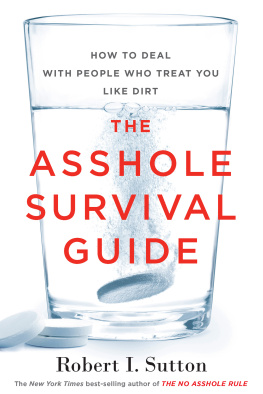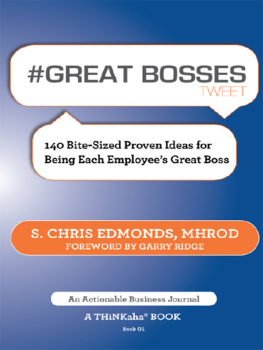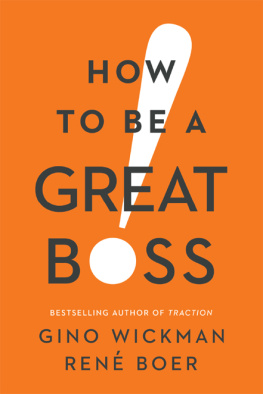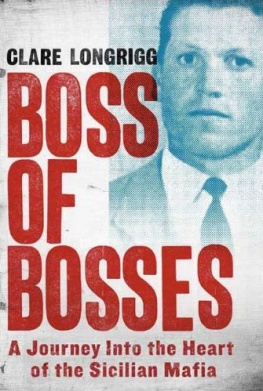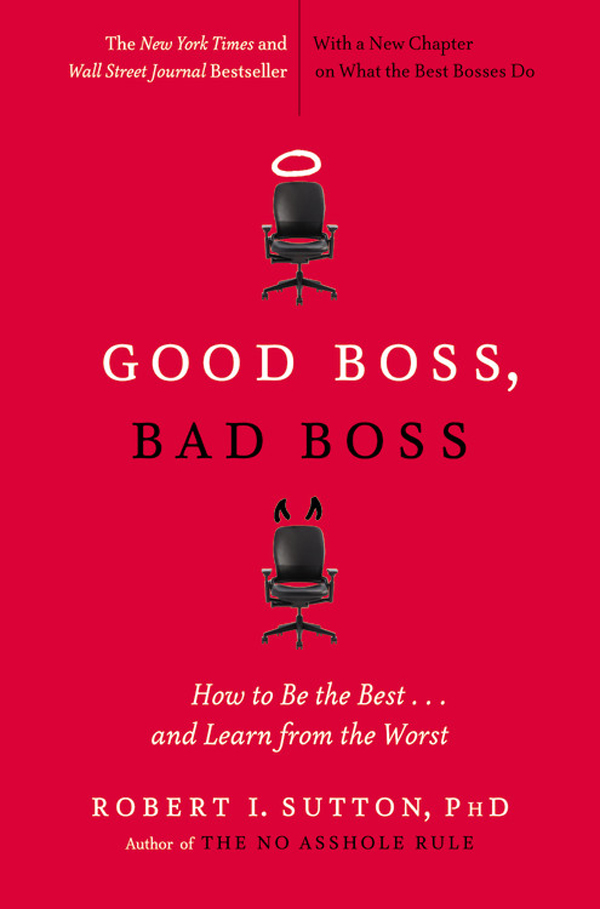Copyright 2010 by Robert I. Sutton
Epilogue Copyright 2012 by Robert I. Sutton
All rights reserved. In accordance with the U.S. Copyright Act of 1976, the scanning, uploading, and electronic sharing of any part of this book without the permission of the publisher is unlawful piracy and theft of the authors intellectual property. If you would like to use material from the book (other than for review purposes), prior written permission must be obtained by contacting the publisher at permissions@hbgusa.com. Thank you for your support of the authors rights.
Business Plus
Hachette Book Group
237 Park Avenue, New York, NY 10017
www.hachettebookgroup.com
www.twitter.com/grandcentralpub
First e-book edition: March 2012
Business Plus is an imprint of Grand Central Publishing.
The Business Plus name and logo are trademarks of Hachette Book Group, Inc.
The publisher is not responsible for websites (or their content) that are not owned by the publisher.
The Hachette Speakers Bureau provides a wide range of authors for speaking events. To find out more, go to www.hachettespeakersbureau.com or call (866) 376-6591.
ISBN 978-0-446-55847-1
- If you want to be a Good Boss, what do you need to accomplish day after day?
- If you have a Bad Boss, what can you do about it?
- In short, what are the hallmarks of a Good Boss and worst flaws of a Bad Boss?
Dr. Robert Sutton wrote GOOD BOSS, BAD BOSS to answer these questions, inspired by the thousands of e-mails, articles, blog posts, and conversations provoked by his bestseller The No Asshole Rule. Dr. Sutton now applies his commonsense approach to show how the great bosses in our world differ from those who are just so-so, or, worse yet, downright inept.
If you are the boss, are you a good one? How can you keep honing your skillsand stir your people to give their all and be proud to work for you? Are you in tune with how your words and deeds (and those little looks on your face) affect your followers? What do they really think of youare you aware of how they see you, or do you live in a fools paradise? If they had a choice, would they continue to work for you? Weaving together real-life case studies and pertinent behavioral science research, Sutton delivers a precise and sometimes startling account of what the best bosses do.
delivers a definitive manifesto for anyone who has ever been elevated to a position of authorityand a blueprint of salvation for those whose bosses just dont seem to get it.
Praise for
G OOD B OSS , B AD B OSS
An Inc. Magazine Best Book for Business Owners
A Globe and Mail Top Business Read of the Year
A New York Post Notable Career Book of the Year
Sutton is a fine writer His plain language makes some of the more extreme stories of good and bad bosses that much more credibleeven poignant. Hes consistently entertaining as he informs and teaches a bit.
Miami Herald
A timely guide to being a better manager.
Financial Times
Packed with insight food for thought for organizations large and small.
Reuters
Draws on a wealth of anecdotal experience and academic research to lay out what leaders and managers should be doing every day.
Inc.
I wrote in my last post that Im getting tired of reading business books. But Bob Suttons GOOD BOSS, BAD BOSS is an exception.
PennLive.com
Warm, smart, and freakishly good will keep you at the top of your game.
Chip and Dan Heath, bestselling authors of Made to Stick and Switch
It should be every bosss responsibility to read and understand it.
John Lilly, CEO, Mozilla Corporation
Clear and compelling a must read teaches the art and science of practical leadership for the twenty-first century.
Brad Smith, CEO, Intuit
We are damned lucky to have Bob Sutton. This book is as good as it gets.
Tom Peters, coauthor of In Search of Excellence
To Marina, for every sweet little thing
M y last book, The No Asshole Rule, is about the damage done by workplace jerks, what it takes to survive a nasty workplace, and how organizations can screen out, reform, and expel these demeaning and destructive creeps. I was overwhelmed by the sheer volume of reactions to the book, and more so by the pain, fear, and desperate cries for help (and success stories, too) that I heard and responded to day after day. As a colleague put it, Bob, you have become the asshole guyits a job that takes a lot of time and emotional energy. I was inundated with asshole stories from all over the world. Thousands of personal stories, survival tips, and new studies poured in via e-mail and comments on my blog, calls from complete strangers, and nearly every work-related conversation that I hadregardless of the advertised topic of a meeting, class, or speech. There was no escaping it outside of work either. People told me asshole stories everyplace I went: cocktail parties, family gatherings, soccer games, weddings, a bat mitzvah, a funeral, and even a parent-teacher conference.
The deluge has slowed but not stopped. Consider a recent week. I received and answered nineteen asshole e-mails, including those from a police sergeant in New York, a Starbucks barista in Chicago, an accountant from Italy, and an HR manager from Wisconsin who struggled to implement the no asshole rule in a small company (her old boss loved it, but her new boss is a screamer and thinks it is a dumb idea). about the asshole-management methods used by people who work with Academy Awardwinning producer Scott Rudinwho is infamous for his tirades, tantrums, and burning through as many as fifty assistants a year. One tip for dealing with Rudin was He hates when you look at him; avoid it or you are asking for it. This advice was offered in concert with a (possibly mythical but often-repeated) story that Rudin had dumped an assistant on the side of a Los Angeles freeway as punishment for glancing at him in the rearview mirror too many times. That same week, I spent most of a ninety-minute interview with a Japanese journalist listening to bitter complaints about his temperamental, unfair, and incompetent boss back in Tokyo.
This deluge revealed new twists about how assholes do their dirty work and how to battle back against these creeps. Adamant and enthusiastic readers bombarded me with topics they wanted covered in a sequel to The No Asshole Rule. An Australian consultant asked for tips about dealing with asshole clients. A New Jersey schoolteacher , Bob, will I be seeing The Asshole Shits Again soon?
These pressures and temptations provoked me to start working on a sequel. But a funny thing happened along the way. As I thought about all those stories and conversations, and read pertinent research, I realized the asshole problem wasnt an isolated concern for most employees and in most workplaces. It was intertwined with feelings, opinions, and aspirations that swirled around a central figure: THE BOSS. I realized that the best bosses did far more than enforce the no asshole rule. They took diverse and intertwined steps to create effective and humane workplaces. And the worst bosses werent just guilty of letting assholes rule the roost. Their incompetence reared its ugly head in a host of other ways.
Bosses were the central figures in most stories I heard about the creeps who damaged employees performance and self-worth. Consider the salesman whose e-mail was titled, Had leukemia, bullied by a bad manager. When chemotherapy began draining his energy, his wicked boss doubled his sales quota and called each day to berate him for being a wimp and a fuckup. Or the legal secretary who was treated as if she were invisible by the attorneys she served. These pompous and self-absorbed jerks never greeted her when passing by and often held long and loud conversations right in front of her deskwithout stopping for a moment to acknowledge her existence. Or the obstetrician who was belittled so brutally by senior physicians during her training that it undermined her confidence during difficult deliveries throughout her career.


